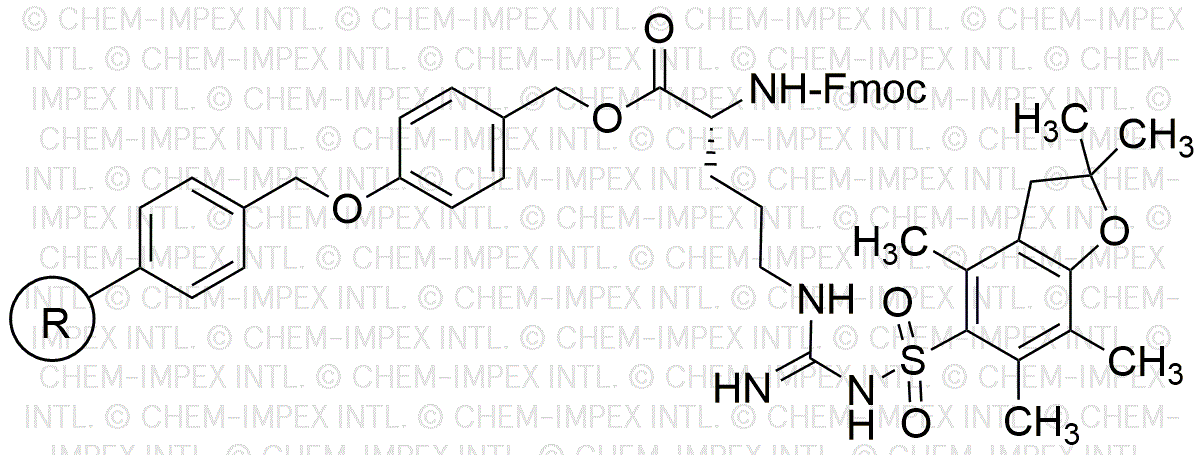Na-Fmoc-Nw-(2,2,4,6,7-pentamethyldihydrobenzofuran-5-sulfonyl)-D-arginine 4-alkoxybenzyl alcohol res is widely utilized in research focused on:
- Peptide Synthesis: This compound serves as a crucial building block in the synthesis of peptides, allowing researchers to create complex molecules for drug development.
- Bioconjugation: It is used in bioconjugation processes to attach biomolecules to surfaces or other molecules, enhancing the functionality of therapeutic agents.
- Drug Delivery Systems: The compound can be incorporated into drug delivery systems, improving the targeted delivery of therapeutic agents to specific cells or tissues.
- Research in Neuroscience: Its unique structure makes it valuable in neuroscience research, particularly in studying receptor interactions and signaling pathways.
- Development of Diagnostic Tools: This chemical is also applied in the development of diagnostic tools, aiding in the detection of diseases through innovative biosensing technologies.
Información general
Propiedades
Seguridad y normativas
Aplicaciones
Na-Fmoc-Nw-(2,2,4,6,7-pentamethyldihydrobenzofuran-5-sulfonyl)-D-arginine 4-alkoxybenzyl alcohol res is widely utilized in research focused on:
- Peptide Synthesis: This compound serves as a crucial building block in the synthesis of peptides, allowing researchers to create complex molecules for drug development.
- Bioconjugation: It is used in bioconjugation processes to attach biomolecules to surfaces or other molecules, enhancing the functionality of therapeutic agents.
- Drug Delivery Systems: The compound can be incorporated into drug delivery systems, improving the targeted delivery of therapeutic agents to specific cells or tissues.
- Research in Neuroscience: Its unique structure makes it valuable in neuroscience research, particularly in studying receptor interactions and signaling pathways.
- Development of Diagnostic Tools: This chemical is also applied in the development of diagnostic tools, aiding in the detection of diseases through innovative biosensing technologies.
Documentos
Hojas de datos de seguridad (HDS)
La SDS proporciona información de seguridad completa sobre la manipulación, el almacenamiento y la eliminación del producto.
Especificación del producto (PS)
La PS proporciona un desglose completo de las propiedades del producto, incluida la composición química, el estado físico, la pureza y los requisitos de almacenamiento. También detalla los rangos de calidad aceptables y las aplicaciones previstas del producto.
Certificados de análisis (COA)
Busque certificados de análisis (COA) ingresando el número de lote del producto. Los números de lote y de partida se pueden encontrar en la etiqueta de un producto después de las palabras "Lote" o "Lote".
Número de catálogo
Número de lote/lote
Certificados de origen (COO)
Este certificado de origen confirma el país en el que se fabricó el producto y también detalla los materiales y componentes utilizados en él y si se deriva de fuentes naturales, sintéticas u otras fuentes específicas. Este certificado puede ser necesario para cumplir con las normativas aduaneras, comerciales y regulatorias.
Número de catálogo
Número de lote/lote
Hojas de datos de seguridad (HDS)
La SDS proporciona información de seguridad completa sobre la manipulación, el almacenamiento y la eliminación del producto.
DownloadEspecificación del producto (PS)
La PS proporciona un desglose completo de las propiedades del producto, incluida la composición química, el estado físico, la pureza y los requisitos de almacenamiento. También detalla los rangos de calidad aceptables y las aplicaciones previstas del producto.
DownloadCertificados de análisis (COA)
Busque certificados de análisis (COA) ingresando el número de lote del producto. Los números de lote y de partida se pueden encontrar en la etiqueta de un producto después de las palabras "Lote" o "Lote".
Número de catálogo
Número de lote/lote
Certificados de origen (COO)
Este certificado de origen confirma el país en el que se fabricó el producto y también detalla los materiales y componentes utilizados en él y si se deriva de fuentes naturales, sintéticas u otras fuentes específicas. Este certificado puede ser necesario para cumplir con las normativas aduaneras, comerciales y regulatorias.

